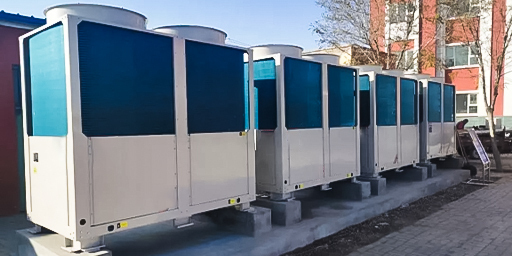Winter antifreeze guide for air energy heat pump units
The last solar term of autumn has passed the frost, and it is running into winter. Some areas in the north are now heating. As we all know, the heat preservation and antifreeze measures of the air energy heat pump unit for heating in winter are very important, otherwise, it will bring direct economic losses to the users. So, how to do a good job of the antifreeze measures for the unit? Let’s first analyze the reasons for the freezing and cracking of the unit. There are three main reasons:
1. The unit is powered off for a long time
When the temperature is lower than -5°C, if the power outage lasts for more than 4 hours, it is likely to cause the heat exchanger to freeze and crack. In particular, when the fluorine system and the water system are frozen at the same time when the compressor restarts after the power are turned on, the compressor will directly suck the water in the external water circuit into the fluorine system, causing the entire unit to be scrapped. Therefore, when it is judged that the power may be cut off for a long time, all the water in the unit, water pump, and outdoor pipeline should be drained in time to prevent the unit from freezing.
2. The design of the main board of the unit has no antifreeze protection function
When the temperature is lower than 0°C, as long as the unit is powered on, the unit will automatically supply power to the circulating pump for 10 to 15 seconds every 30 minutes, allowing the hot water in the water tank to circulate between the water tank and the main unit, and use the hot water in the water tank to Valves, pipelines, water pumps, and unit heat exchangers are heated to prevent freezing and cracking. However, if the branded equipment used does not have the antifreeze protection function, once a problem occurs, the heat exchange sleeve may be frozen and cracked.
3. There is no/short connection to the water flow switch, and the temperature probe is not allowed
When the air energy heat pump is cooling in summer, the unit stops working when the water temperature is 0°C-10°C and starts working when the water temperature is higher than 15°C. If the water temperature probe is inaccurate, for example, the water temperature has reached 0°C, but the probe shows that the temperature is still at 25°C (over 15°C), then the machine will judge that the water temperature has not reached the temperature that needs to be shut down, and will continue to refrigerate. At this time, if the water flow switch is not installed or the water flow switch is short-circuited, it is likely to cause the unit to freeze and crack.
Winter antifreeze matters for air energy heat pump units! Specifically, it can be carried out from the following aspects.
01. Strengthen the insulation effect of the pipeline
It is important to keep pipes warm, as exposed water pipes will cool down as the outside environment cools. With the insulation layer, the water pipe will be warm, and the temperature of the water in the pipe will not drop too much or too fast.
When connecting pipe sleeves with pipe sleeves, thermal insulation glue must be applied to the end face (circumferential seam) of pipe sleeves. Seal the seams with glue. When the pipe sleeve is connected with the main unit and the wall, the end faces of the pipe sleeve, the main unit, and the wall must be coated with thermal insulation glue respectively.
02. Do not power off the unit
Air energy heat pump heating uses water as the medium for heat transfer. Shinco air energy heat pumps have an antifreeze function. When the water temperature drops to a certain temperature, the machine will automatically start to prevent equipment and pipelines from freezing.
If the weather temperature is low and the power to the air energy heat pump is cut off, the water temperature in the pipeline may drop sharply, which may freeze the equipment and cause a malfunction. Therefore, when the heat pump unit does not operate for a long time, the water in the unit, water pump, and outdoor pipeline should be drained in time to prevent the unit from freezing. the
03. Condensed water should be treated in time
During the heating process of the air source heat pump, a large amount of condensed water will be discharged. If the temperature is below zero, the condensed water is easy to freeze, which may freeze the drain pipe, and then climb up along the drain pipe, and finally cause the equipment to fail to operate normally, so the condensed water should be cleaned regularly.
The following methods can be used to deal with it: raise the installation position of the main engine. Under normal circumstances, the height of the main engine from the ground should not be less than 30 cm. For areas with severe ice and snow, it is recommended to be at least 50 cm above; De-icing; Wrap the heating cable on the outer wall of the condensate or defrosting water drainage pipe to prevent freezing.
04. Open the three-way water inlet and outlet, and install the emptying valve
During installation, a drain valve and a drain pipe should be installed at the lowest point of the water system. Even if it is not at the lowest point of the unit, a drain valve should be installed at the inlet and outlet of the unit. When there is a power outage for more than two hours or a long-term shutdown, open the drain valve at the water inlet and outlet to drain the water in the water pump of the main engine to prevent freezing and cracking after the temperature drops, and cut off the power supply. Then, when it is running again, it is necessary to conduct a comprehensive inspection of the air source heat pump system to ensure that there is no failure.
05. Add antifreeze to the system
For the heating unit, it is recommended to add antifreeze to the pipeline of the unit, such as -15℃, -25℃ antifreeze.
06. Clean up debris and snow around the fuselage in time
If the heat pump is installed in the back of the sun and the ventilation is not good, it will affect the heating effect of the heat pump. Therefore, it is necessary to clean up the surrounding sundries, otherwise, it will affect the dissipation of cold air, which will lead to insufficient heat in the air and affect the cooling system. heat effect.



